Roughly following the border of England and Wales, as it has done for well over a millennium, Offa’s Dyke Path winds through moorlands and mountains and is one of the best, most historic trails in the UK.
In fact, the path is the nation’s longest ancient monument, a mighty 176-mile legacy of 8th-century Anglo-Saxon England, running from Prestatyn in North Wales to Chepstow on the Severn estuary at a rough height of 2.4 metres. Here’s our guide to the path’s past and the best places to enjoy it today.

The history behind Offa’s Dyke
Offa’s Dyke was built in the so-called Dark Ages when little was written down, so it remains largely shrouded in mystery to this day – perhaps partly explaining its lesser known status both in British history and as a walking destination.
Academics and historians are still quibbling over the dyke’s precise length and remain divided over its purpose. It is generally agreed, though, that the dyke was constructed under the orders of the Anglian King Offa of Mercia during the 8th century. Many believe this was to defend his kingdom from the Welsh, while others argue there is little evidence to suggest it was built for defensive reasons – it may have been a practical boundary or a showy demonstration of the king’s power and wealth.
Whatever its purpose, we can thank Offa for inadvertently providing modern Britain with some of the country’s best walks over 1200 years later. Although there are gaps where the earthwork has not survived, what remains ambles through extremely picturesque countryside and can be tackled as one long route or a series of day trips. The present day path was built in 1971 as a long-distance walking trail and runs alongside or on top of the dyke for much of its length, taking a slightly different course in some worn out places.

Recommended short hikes
If you only have time for one walk
Perhaps the most famous stretch is found in the Lower Wye Valley, where the trail passes historic market towns, crumbling abbey ruins and ancient woodlands all built up along the pleasant meadow banks of the River Wye. Walk up to the Devil’s Pulpit, a limestone crag nestled amid an area of woodland, and you’ll be rewarded with stunning views over the ruins of Tintern Abbey. It’s worth taking some time to explore this part of the valley so spend the night in a 13th-century castle (built by Edward I) which is now a youth hostel. Popular among walkers, it’s in the nearby village of St Briavels.
The trail cuts into the Brecon Beacons National Park before crossing paths with the River Wye’s idyllic valleys once again as it intersects Hay-on-Wye, the home of Britain’s most loved literature festival. This neck of the woods is also part of an international dark sky reserve making it one of the world’s best stargazing spots and there’s no better place to gaze into the night than the crumbling monastery ruins of Llanthony Priory. For a heightened perspective, scale Hay Bluff or Lord Hereford’s Knob – either hill provides stunning views over glorious green fields. There are plenty of accommodation options in the region; many walkers break up their journey by staying at the priory hotel.

An easy introduction to the path
The walk from Gladestry to Kington in Herefordshire offers a remarkable sense of the original trail in a short stretch of walk. It also boasts 360 degree views over the countryside as it ascends Hergest Ridge, where there are the remains of an old Victorian racecourse at the summit. Pen y Fan, the Malvern Hills and the Shropshire Hills can all be seen in the distance on a clear day. You’ll likely notice a bizarre clump of monkey puzzle trees thriving on top of the ridge as well, planted by local gardener Dick Banks as an experiment after he noticed the species growing in similar climates in Chile. Combine the day out with a visit to Hergest Croft Gardens, the home of many more rare and unusual species of plants, trees and shrubs collected from around the globe by the Banks family through five generations. Those seeking a full day of walking can continue on the trail to the historic market town of Knighton, where the Offa’s Dyke Association is located.

For the dedicated walkers
From Knighton, the trail continues its route through the Shropshire Hills and the Clwydian Hills before reaching the coast. The Shropshire Hills Area of Outstanding Beauty is thought to be one of the toughest areas of the path, but is also one of the most tranquil and rustic. There are some well preserved sections of dyke to be found as you make your way over Llanfair Hill. Keep pressing on and you’ll find the midway marker just beyond Newcastle on Clun. Further along in North Wales, the path takes you through some true wilderness as it traverses spectacular Eglwyseg Valley near Llangollen and continues its journey to the World’s End vale. Keep going and you’ll eventually Prestatyn and the path’s northern terminus.
